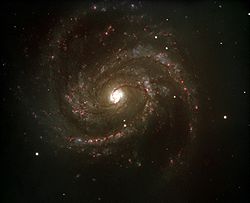Messier 100
| Messier 100 | |
|---|---|
 |
|
| Observation data (J2000 epoch) | |
| Constellation | Coma Berenices |
| Right ascension | 12h 22m 54.9s |
| Declination | +15° 49′ 21″ |
| Redshift | 1571 ± 1 km/s |
| Distance | 55 Mly |
| Apparent magnitude (V) | 9.5 |
| Characteristics | |
| Type | SAB(s)bc |
| Size | 107,000 ly (diameter) |
| Apparent size (V) | 7′.4 × 6′.3 |
| Other designations | |
| NGC 4321 | |
Messier 100 (also known as NGC 4321) is an example of a grand designintermediate spiral galaxy located within the southern part of constellation Coma Berenices. It is one of the brightest and largest galaxies in the Virgo Cluster, located approximately 55 million light-years distant from Earth and has a diameter of 107,000 light years. It was discovered by Pierre Méchain on March 15, 1781 and was subsequently entered in Messier’s catalogue of nebulae and star clusters after Charles Messier made observations of his own on April 13, 1781. The galaxy was one of the first spiral galaxies to be discovered, and was listed as one of fourteen spiral nebulae by Lord William Parsons of Rosse in 1850. Two satellite galaxies named NGC 4323 -connected with M100 by a bridge of luminous matter- and NGC 4328 are present within this galaxy.
After the discovery of M100 by Méchain, Charles Messier made observations of the galaxy depicting it as a nebula without a star. He pointed out that it was difficult to recognize the nebula because of its faintness. William Herschel was able to identify a bright cluster of stars within the nebula during observations he did before John Herschel expanded the findings in 1833. With the advent of better telescopes, John Herschel was able to see a round, brighter galaxy; however, he also mentioned that it was barely visible through clouds. William Henry Smyth extended the studies of M100, detailing it as a pearly white nebula and pointing out diffuse spots.
...
Wikipedia
